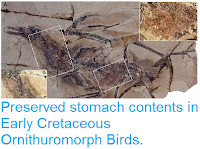Hesperornithiforms were a group of toothed Seabirds known from the Late Cretaceous of North America and Eurasia, with their maximum diversity found around the shores of the Western Interior Seaway of North America. They are interpreted as having been pursuit-diving, Fish-eating seabirds similar to modern Gannets and Boobies.
In a paper published in the Canadian Journal of Earth Sciences on 29 July 2016, Laura Wilson of the Sternberg Museum of Natural History at Fort Hays State University and the Department of Geological Sciences at the University of Colorado, Boulder, Karen Chin also of the Department of Geological Sciences and of the Museum of Natural History at University of Colorado, Boulder, and Stephen Cumbaa of the Canadian Museum of Nature, describe a new Hesperornithiform specimen from the Late Cretaceous Kanguk Formation of Devon Island in Nunavut Territory, in the Canadian High Arctic.
The specimen comprises the left and right femora, four teeth, partial left and right ilia, rib fragments, and assorted bone fragments. This is refereed to the genus Hesperornis, but not to species level due to the fragmentary nature of the material. The specimen is believed to have become disarticulated while exposed on the seafloor before being buried, and was further damaged when exposed prior to excavation, with some material being lost at this time as it could not be extracted from the permafrost.
Scanning electron microscope photomicrographs of the four teeth preserved with NUVF 286. Note the recurved crown, fine crenulations in the enamel, and absence of serrations. Wilson et al. (2016).
Hesperornithiform Birds are generally reconstructed as having been Fish-eating Birds, consuming small-to-medium sized Fish which were actively pursued in the water. However no such Fish are known from the Kanguk Formation, or other deposits from the Late Cretaceous High Arctic, raising questions about the diet of the Hesperornithiform Birds found there. It is possible that such Fish were possible in the High Arctic at this time, but that they have not been preserved, but given the good fossil record of large Fish, other Vertebrates and Invertebrates from these deposits, Wilson et al. suggest this is unlikely.
As an alliterative they suggest that Arctic ecosystems in the Late Cretaceous may, as is the case now, have had much shorter food chains than those at lower latitudes. Mesozoic Arctic ecosystems are somewhat of a mystery to palaeontologists, as temperatures at the time were to warm for the formation of permanent pack ice as it the case today, but the Earth's tilt would still have caused long periods of winter darkness, thus creating an environment with no direct analogue today. Wilson et al. suggest that this may have been similar enough to modern Arctic ecosystems to prevent the development of long food chains, instead leading to a situation similar to that seen today in which large animals at the top of the food chain feed directly on small invertebrates at the bottom, such as the Krill fed upon by many large Animals today.
See also...
Follow Sciency Thoughts on Facebook.







